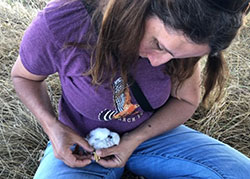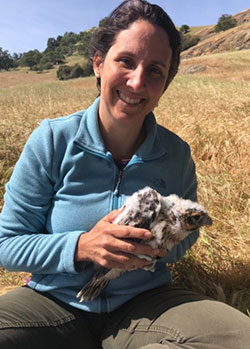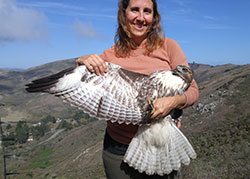
Banding an American Kestrel chick as part of a nest box monitoring study.

Battistone holding a Red-tailed Hawk trapped and banded at the Golden Gate Raptor Observatory.

Battistone holding a Prairie Falcon chick just prior to placing bands on the bird and returning it to the nest.
As CDFW’s Statewide Raptor Conservation Coordinator, Carie Battistone manages the department’s efforts related to conservation, policy, regulation and research of hawks, eagles, owls, condors and other birds of prey. Her responsibilities include overseeing listing petitions for endangered or threatened species, coordinating with a diverse set of partners on various research and conservation efforts including the Condor Recovery Program, Barred Owl Science Team, Northern Spotted Owl Interagency Working Group and Golden Eagle Science Team.
Battistone’s training includes two degrees from the University of California, Davis. She earned a bachelor’s degree in wildlife biology and a master’s degree in avian ecology. Battistone began working for California Department of Fish and Wildlife (CDFW) as a contractor in the late 1990s, helping manage the state’s spotted owl database and conducting field surveys on grouse, willow flycatchers and great grey owls. After getting her master’s degree which included work on CDFW’s great grey owl project, she joined the department full-time in 2005, and in 2009 was hired as the state’s raptor coordinator.
What sparked your interest in raptors?
Raptors have always kind of been my interest – although I do have an interest in all wildlife, not just raptors. When I was a kid, my family went camping a lot and did a lot of activities outdoors. A love of the outdoors was instilled in me early. I became more interested in raptors while doing my undergraduate work. Raptors are these top predators with this powerful aura around them, but they still have their vulnerabilities and weaknesses. They need us to preserve habitat and identify threats.
What facts about raptors do you most enjoy educating people on?
I probably end up talking most about the threats raptors face. Since the public is drawn to raptors, we can use them to show the impacts of contaminants like lead and rodenticides. Anyone who sees an eagle go through the effects of lead toxicosis – which can include seizures and ultimately death – will get the message about the need to protect them from this outcome. People have to know how to use rodenticides correctly and how they can impact wildlife. It’s similar with some renewable energy projects. There are collision mortalities associated with wind energy projects, and even solar to some degree. Renewable energy is important, but again we should be thinking about them in light of their potential impacts. I don’t like being a ‘Debbie Downer’ when I talk about raptors, but I do want to convey the reality of the threats they face.
Are there any raptor species in California that people might not be familiar with?
The public may be less familiar with some individual species of raptors. For example, most people know the red-tailed hawk. In California, we have other species of hawks that have some very interesting habits, like the Swainson’s hawk, which makes a long-distance migration back and forth from South America in the winter to California to breed. The public may not be as familiar with some of the smaller owl species like the saw-whet owl, western screech-owl and elf owl. Most of the bigger more charismatic owls are well-known, such as the spotted owl and great-horned owl. But these small owls are very captivating! The public may not be aware of some of the major threats facing even the more well-known species, such as the spotted owl. The plight of the spotted owl is interesting because they have a long history of conflicts with the timber industry dating back to the 1990s when they were listed under the Endangered Species Act. More recently, the spotted owls face a new threat, the non-native barred owl. Barred owls are bigger, more aggressive, and eat a wider variety of prey, and they often displace spotted owls from their habitat. This presents a challenge for managers and conservationists because it becomes an issue of species vs. species. There has been a lot of tension because one proposal is lethally removing barred owls to allow spotted owls to thrive. We’re trying to do outreach to help the public understand what it would mean for the spotted owl if we don’t take action.
What’s the greatest challenge facing raptors as a whole?
I wouldn’t say there’s any one greatest challenge, but rather a whole suite of them. It depends on the species. The forests in our state are changing due to climate change, fires, disease, etc., so raptors that live in and depend on the forest – the northern goshawk and spotted owl for example – face their own set of challenges. Species like the elf owl may be experiencing habitat degradation and loss in desert riparian areas, heightened by impacts from climate change. Raptors that live in urban environments – like the peregrine falcon and Cooper’s hawk – face issues like poisoning and collisions with buildings. The grasslands in our state are disappearing, so birds that rely on those areas, such as the short-eared owl, are dealing with habitat challenges as well.
Are there any species of raptors that are thriving?
Cooper’s hawks, red-tailed hawks and the peregrine falcon are doing fairly well, and all three are well-suited to live in urban landscapes. Bald eagles are making a comeback as well, though they are still listed as threatened. You can see bald eagles in a lot more places in California, which wasn’t the case years ago. There were only a handful of pairs in the northern part of the state, and now we’re seeing them throughout California and even nesting in urban areas. The Swainson’s hawk is listed as threatened, but we’re seeing population increases and range expansion from them.
Which species are you most concerned about?
I’m concerned about the American kestrel and short-eared owl. Kestrels are fairly common, but populations are declining – not just in California, but across the west. There are efforts to figure out what’s going on with the population before it reaches a critical point. Short-eared owls used to be more common in grassland habitats in California, even down into San Diego County. But now, it is rare to detect these birds breeding in the state. They’re a grassland dependent species, so they are most likely being impacted by the changing composition of grasslands in our state. There are areas in California where golden eagles are fairly dense, but they seem to be rarer in other areas of the state. In all cases, we don’t have a good sense of why these species are seeing declines. It may be due to prey availability, encroachment from urban landscape, decreasing habitat or contaminants.
What’s the most challenging part of your job?
Obtaining funding for much-needed research can be very challenging. Funding for raptor conservation, or nongame species in general, can be harder to come by than for game species. Also, it is sometimes difficult to create a meaningful and clear message to the public regarding some of the threats raptors face, and what people can do about these threats.
What’s the best part of your job?
Seeing a difference and making an impact. I enjoy bringing people together and talking about how to resolve an issue or how to do research in a meaningful way. With the science teams and workgroups that I help manage, the goal is often coming up with a realistic solution that also makes a difference. At the end of the day, it’s all about what we can do to benefit the species and their habitat.
Do you work directly with raptors?
Sometimes. For example, I contribute to the American Kestrel Partnership by helping band nestlings as part of the nest box program and trap and band adults during the winter. I also help do surveys on some species, like short-eared owls and Swainson’s hawks, and get to go out with some of the researchers to assist as needed with condors and prairie falcons. Occasionally I can make it out to help the Golden Gate Raptor Observatory with their annual banding program for migratory raptors.
What are your goals for CDFW’s raptor conservation program?
Besides continuing partnerships and research, one goal that I have is to build the department’s citizen science capabilities, so we can get assistance from the public for surveys and other needs we have a hard time funding with permanent staff. If we had a dedicated citizen science program, it could benefit not only raptors but so many other wildlife species. People are excited to help and getting them involved would create a good educational tool. It’s an excellent way to liaison with the public and get them engaged with the issues each species faces. People involved at this level really feel a sense of ownership about the wildlife they’re helping and are more apt to make decisions and take actions that help.
CDFW Photos.